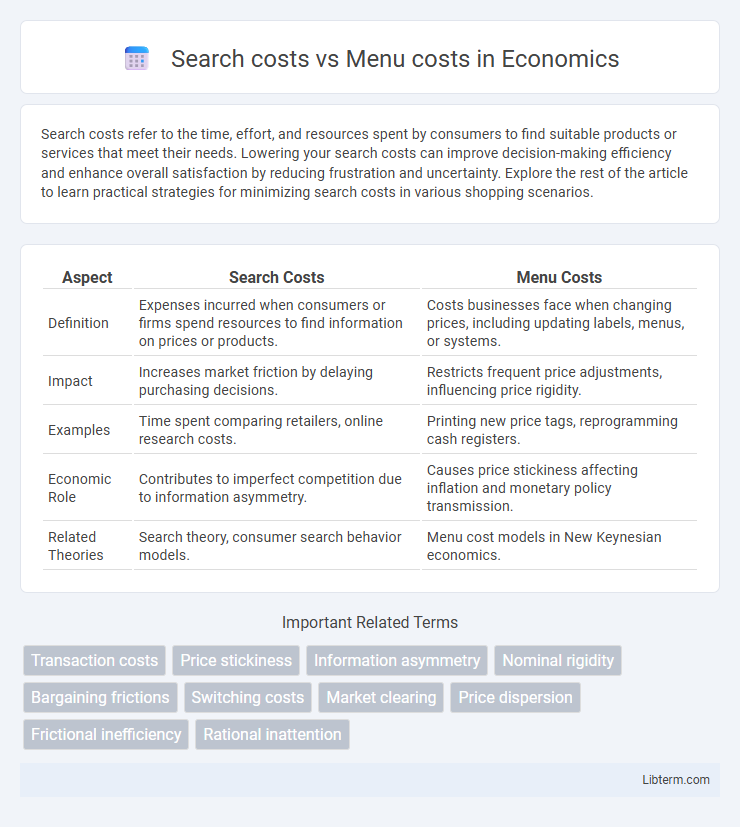Search costs refer to the time, effort, and resources spent by consumers to find suitable products or services that meet their needs. Lowering your search costs can improve decision-making efficiency and enhance overall satisfaction by reducing frustration and uncertainty. Explore the rest of the article to learn practical strategies for minimizing search costs in various shopping scenarios.
Table of Comparison
| Aspect | Search Costs | Menu Costs |
|---|---|---|
| Definition | Expenses incurred when consumers or firms spend resources to find information on prices or products. | Costs businesses face when changing prices, including updating labels, menus, or systems. |
| Impact | Increases market friction by delaying purchasing decisions. | Restricts frequent price adjustments, influencing price rigidity. |
| Examples | Time spent comparing retailers, online research costs. | Printing new price tags, reprogramming cash registers. |
| Economic Role | Contributes to imperfect competition due to information asymmetry. | Causes price stickiness affecting inflation and monetary policy transmission. |
| Related Theories | Search theory, consumer search behavior models. | Menu cost models in New Keynesian economics. |
Introduction to Search Costs and Menu Costs
Search costs refer to the time, effort, and resources consumers or firms expend to find the best prices or products in the market, impacting decision-making efficiency and market competition. Menu costs represent the expenses businesses incur when changing prices, including printing new menus, re-tagging items, and updating systems, which can lead to price stickiness. Both search costs and menu costs influence market dynamics by affecting how quickly and efficiently prices adjust to changes in supply and demand.
Defining Search Costs in Economics
Search costs in economics refer to the time, effort, and resources expended by consumers or firms to find and compare products or prices before making a purchase decision. These costs include the physical or digital effort to gather information, evaluate options, and identify the best available deal. Minimizing search costs can lead to more efficient market outcomes by reducing barriers to informed decision-making.
Understanding Menu Costs in Business
Menu costs in business refer to the expenses firms incur when changing prices, such as reprinting menus, updating labels, or altering advertising materials. These costs can deter frequent price adjustments, leading companies to maintain stable pricing even amid fluctuating market conditions. Understanding menu costs helps businesses balance the trade-off between adapting to market changes and minimizing operational expenses.
Key Differences Between Search Costs and Menu Costs
Search costs refer to the time, effort, and resources consumers or firms expend to find the best price or product in the market, directly impacting purchasing decisions and market efficiency. Menu costs represent the expenses borne by firms to change prices, such as printing new menus or updating digital price tags, affecting pricing strategies and frequency of price adjustments. The key difference lies in search costs influencing consumer behavior and market search dynamics, while menu costs pertain to the supply-side friction in price modification.
Factors Influencing Search Costs
Search costs are primarily influenced by product variety, information availability, and consumer expertise, which affect the effort and time needed to find desired goods or services. High search costs arise when consumers encounter numerous options, limited product data, or have low familiarity with the market, leading to increased decision-making complexity. Digital technologies and online platforms can reduce search costs by enhancing access to detailed product information and user reviews, thereby facilitating more efficient comparisons.
Factors Affecting Menu Costs
Menu costs are influenced by factors such as the complexity of updating prices, frequency of price changes, and the technological infrastructure used by businesses. High customization levels in product offerings and the cost of printing or digital updates increase menu costs significantly. Firms operating in highly competitive markets or with rapidly changing input costs face higher menu costs due to the necessity of frequent adjustments.
The Impact of Digitalization on Search Costs and Menu Costs
Digitalization drastically reduces search costs by providing instant access to extensive product information and price comparisons through online platforms and mobile apps. Automation and dynamic pricing software minimize menu costs by enabling rapid updates to prices and product offerings without manual intervention. The intersection of digital tools enhances market efficiency, allowing businesses to respond swiftly to consumer demand and competitive pricing pressures.
Real-World Examples of Search and Menu Costs
Search costs refer to the time and effort consumers spend finding the best price or product, often seen in online shopping platforms where users compare different sellers to secure a deal. Menu costs arise when firms change prices, such as restaurants printing new menus to reflect updated food prices or retailers updating price tags during sales. Real-world examples include airline companies regularly adjusting fares (menu costs) while passengers spend time comparing flight options across multiple websites (search costs).
Strategies to Minimize Search and Menu Costs
Businesses reduce search costs by implementing user-friendly website navigation and employing advanced algorithms that personalize product recommendations based on consumer behavior data. To minimize menu costs, firms adopt dynamic pricing software and digital menus that allow instant updates without physical replacement, significantly cutting adjustment expenses. Leveraging automated pricing tools and real-time data analytics streamlines price changes and improves overall cost efficiency in both search and menu processes.
Conclusion: Balancing Search Costs vs Menu Costs in Modern Markets
Efficient market functioning requires balancing search costs, the effort consumers expend to find information, against menu costs, the expenses firms face when changing prices. Minimizing search costs improves consumer decision-making and market transparency, while controlling menu costs helps businesses maintain pricing stability and reduce operational friction. Optimal market strategies integrate technology to lower search costs without triggering excessive price adjustments, fostering dynamic yet stable pricing environments.
Search costs Infographic

 libterm.com
libterm.com